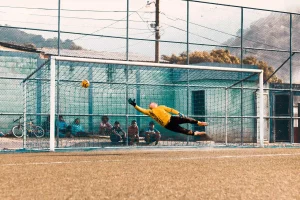The psychology of soccer apparel design delves into how cultural psychology significantly impacts the fashion choices in soccer apparel. It goes beyond logos and color schemes, reflecting a complex web of cultural nuances. From African teams’ bold graphics to European clubs’ understated elegance, each region’s distinct fashion sensibilities are deeply rooted in cultural heritage and values. Cultural psychology drives these design choices, varying across regions and markets, with specific factors influencing visual identity.
Key Takeaways
- Cultural psychology influences soccer apparel design, reflecting nuanced differences in fashion sensibilities across geographical boundaries.
- Social identity theory roots the design of soccer jerseys, evoking comfort, nostalgia, and emotional attachment among fans.
- Cultural considerations are crucial in appealing jersey design, as symbolisms and values are deeply rooted in local histories and aesthetics.
- Global trends in soccer merchandise, such as personalization and sustainability, are shaped by cultural, economic, and psychological factors.
- Apparel design serves as a visual representation of cultural identity, weaving together national pride, team loyalty, and personal expression.
Cultural Nuances in Soccer Fashion
Soccer apparel design, a reflection of cultural identity, is influenced by nuanced differences in fashion sensibilities that vary across geographical boundaries, underscoring the significance of cultural psychology in shaping the aesthetics of the sport. These differences are evident in the distinct styles and trends that emerge in various regions, highlighting the complex interplay between culture and fashion.
The Psychology of Soccer Apparel Design
As cultural identity is intricately woven into the fabric of fashion, the psychology underlying soccer apparel design reveals a complex tapestry of cultural influences, personal preferences, and social norms that shape the aesthetic appeal of the sport. The psychology of soccer apparel design is rooted in:
- Social identity theory, where fans wear team jerseys to signal allegiance and belonging.
- Cognitive fluency, where familiar designs and colors evoke a sense of comfort and nostalgia.
- Emotional attachment, where apparel becomes a symbol of shared experiences and memories.
Soccer Jersey Design Across Cultures
Across different cultural contexts, jersey designs reflect nuanced variations in aesthetic preferences, symbolisms, and cultural values that are deeply rooted in local histories and traditions. For instance, Japanese jerseys often feature minimalist designs, while Brazilian jerseys are known for vibrant colors and bold graphics. The psychology of soccer apparel design influences these design decisions, highlighting the importance of cultural considerations in creating appealing jerseys.
Global Trends in Soccer Merchandise
What drives the global soccer merchandise market, where replica jerseys and team-branded accessories have become a multi-billion-dollar industry, is a complex interplay of cultural, economic, and psychological factors. Key trends shaping this market include:
- Globalization: The increasing popularity of international soccer tournaments and leagues.
- Personalization: Fans seeking unique, customized apparel to express their team loyalty and individuality.
- Sustainability: The growing demand for eco-friendly, socially responsible merchandise.
These factors greatly influence the psychology of soccer apparel design, driving market growth and shaping consumer behavior.
Apparel Design as Cultural Expression
Soccer apparel design serves as a visual representation of cultural identity, weaving together threads of national pride, team loyalty, and personal expression. The psychology of soccer apparel design is deeply rooted in cultural psychology, where designers intentionally craft visual narratives that evoke emotions and create a sense of belonging among fans.

Frequently Asked Questions
How Do Soccer Apparel Designers Balance Cultural Sensitivity With Market Appeal?
Soccer apparel designers strike a balance between cultural sensitivity and market appeal by conducting thorough cultural research, collaborating with diverse stakeholders, and incorporating nuanced design elements that respectfully nod to cultural heritage while appealing to a broad audience.
Can Cultural Psychology Influence the Popularity of Specific Jersey Designs?
Cultural psychology greatly impacts jersey design popularity, as consumers’ emotional connections to certain colors, symbols, and patterns are influenced by their cultural backgrounds, values, and beliefs, ultimately driving their purchasing decisions and brand loyalty.
What Role Do Local Soccer Clubs Play in Shaping Regional Apparel Design Trends?
Local soccer clubs greatly influence regional apparel design trends by reflecting community identity, values, and history, thereby fostering a sense of belonging among fans who wear jerseys that symbolize regional pride and loyalty.
How Do Cultural Differences Impact the Use of Colors in Soccer Apparel Design?
Cultural differences greatly influence the use of colors in soccer apparel design, as colors hold distinct symbolic meanings across cultures, with red conveying passion in Spain but symbolizing good luck in China, for instance.
Do Cultural Nuances Affect the Way Sponsors Are Presented on Soccer Jerseys?
Cultural nuances heavily influence the presentation of sponsors on soccer jerseys, as varying values and norms dictate brand visibility, placement, and messaging, reflecting the complex interplay between cultural identity and commercial interests.
Conclusion
The cultural nuances inherent in soccer apparel design underscore the profound impact of cultural psychology on visual expressions. The distinct aesthetics and values embedded in jersey designs and merchandise across cultures demonstrate a deep-seated connection to cultural identity. As a result, a nuanced understanding of cultural psychology is essential for appreciating the intricate relationship between culture, psychology, and soccer apparel design. Ultimately, this understanding can inform the creation of culturally sensitive and effective design strategies that resonate with diverse audiences worldwide.
You May Also Like To Read:





